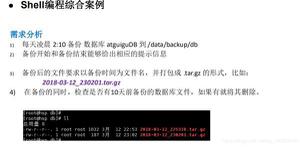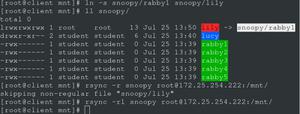使用C在Linux Shell中实现输入/输出重定向
我正在尝试使用C为Linux创建一个基本的shell。在我尝试进行输出重定向之前,它已经可以工作了,并且它破坏了一切。当我运行此代码时,它直接进入fork()的默认情况。我不知道为什么。如果我在子进程中摆脱了for循环,那么它就可以工作,但是即使有了for循环,我也不明白为什么子进程甚至从未输入。如果将打印语句放在子进程的顶部,则不会打印出来。
当我在命令行中运行此命令时,我得到提示并键入“ ls”之类的内容,在添加for循环之前它可以正常工作,但是现在我仅获得“%am i
here”,如果按回车,它将一直给我同一条线。我的目标是能够键入“
ls>输出”并使其正常工作。我认为输入重定向有效,但是说实话,我什至没有花太多时间,因为我对输出重定向发生的事情非常困惑。任何帮助将不胜感激,我已经花了4个小时在相同的15条线上,试图使其正常工作。
#include <stdio.h>#include <stdlib.h>
#include <unistd.h>
#include <string.h>
#include <errno.h>
#include <signal.h>
#include <sys/stat.h>
#include <fcntl.h>
#include <sys/types.h>
#include <sys/wait.h>
#define HISTORY_COUNT 20
char *prompt = "% ";
int
main()
{
int pid;
//int child_pid;
char line[81];
char *token;
char *separator = " \t\n";
char **args;
char **args2;
char **args3;
char cmd[100];
char *hp;
char *cp;
char *ifile;
char *ofile;
int check;
int pfds[2];
int i;
int j;
int current = 0;
int p = 0;
//int check;
char *hist[HISTORY_COUNT];
//char history[90];
//typedef void (*sighandler_t) (int);
args = malloc(80 * sizeof(char *));
args2 = malloc(80 * sizeof(char *));
signal(SIGINT, SIG_IGN);
while (1) {
fprintf(stderr, "%s", prompt);
fflush(stderr);
if (fgets(line, 80, stdin) == NULL)
break;
// split up the line
i = 0;
while (1) {
token = strtok((i == 0) ? line : NULL, separator);
if (token == NULL)
break;
args[i++] = token;
/* build command array */
}
args[i] = NULL;
if (i == 0){
continue;
}
// assume no redirections
ofile = NULL;
ifile = NULL;
// split off the redirections
j = 0;
i = 0;
while (1) { //stackoverflow.com/questions/35569673
cp = args[i++];
if (cp == NULL)
break;
switch (*cp) {
case '<':
if (cp[1] == 0)
cp = args[i++];
else
++cp;
ifile = cp;
break;
case '>':
if (cp[1] == 0)
cp = args[i++];
else
++cp;
ofile = cp;
break;
case '|':
if(cp[1] ==0){
cp = args[i++];
if(pipe(pfds) == -1){
perror("Broken Pipe");
exit(1);
}
p = 1;
}
else{
++cp;
}
break;
default:
args2[j++] = cp;
args3[cp++] = cp
break;
}
}
args2[j] = NULL;
if (j == 0)
continue;
switch (pid = fork()) {
case 0:
// open stdin
if (ifile != NULL) {
int fd = open(ifile, O_RDONLY);
if (dup2(fd, STDIN_FILENO) == -1) {
fprintf(stderr, "dup2 failed");
}
close(fd);
}
// open stdout
if (ofile != NULL) {
// args[1] = NULL;
int fd2;
if ((fd2 = open(ofile, O_WRONLY | O_CREAT, 0644)) < 0) {
perror("couldn't open output file.");
exit(0);
}
// args+=2;
printf("okay");
dup2(fd2, STDOUT_FILENO);
close(fd2);
}
if(p == 1){ //from stackoverflow.com/questions/2784500
close(1);
dup(pfds[1]);
close(pfds[0]);
execvp(args2[0], args2);
break;
}
if(strcmp(args2[0], "cd") == 0){ //cd command
if(args2[1] == NULL){
fprintf(stderr, "Expected argument");
}
else{
check = chdir(args2[1]);
if(check != 0){
fprintf(stderr,"%s",prompt);
}
}
break;
}
execvp(args2[0], args2); /* child */
signal(SIGINT, SIG_DFL);
fprintf(stderr, "ERROR %s no such program\n", line);
exit(1);
break;
case -1:
/* unlikely but possible if hit a limit */
fprintf(stderr, "ERROR can't create child process!\n");
break;
default:
//printf("am I here");
if(p==1){
close(0);
dup(pfds[0]);
close(pfds[1]);
//execvp();
}
wait(NULL);
//waitpid(pid, 0, 0);
}
}
exit(0);
}
回答:
我添加了一个单独的参数传递来捕获和记住I / O重定向,并将其从传递给子级的arg列表中删除。
这是更正后的代码[请原谅免费的样式清理]:
#include <stdio.h>#include <stdlib.h>
#include <unistd.h>
#include <string.h>
#include <errno.h>
#include <signal.h>
#include <sys/stat.h>
#include <fcntl.h>
#include <sys/types.h>
#include <sys/wait.h>
char *prompt = "% ";
int
main()
{
int pid;
//int child_pid;
char line[81];
char *token;
char *separator = " \t\n";
char **args;
char **args2;
char *cp;
char *ifile;
char *ofile;
int i;
int j;
int err;
//int check;
//char history[90];
//typedef void (*sighandler_t) (int);
args = malloc(80 * sizeof(char *));
args2 = malloc(80 * sizeof(char *));
//signal(SIGINT, SIG_IGN);
while (1) {
fprintf(stderr, "%s", prompt);
fflush(stderr);
if (fgets(line, 80, stdin) == NULL)
break;
// split up the line
i = 0;
while (1) {
token = strtok((i == 0) ? line : NULL, separator);
if (token == NULL)
break;
args[i++] = token; /* build command array */
}
args[i] = NULL;
if (i == 0)
continue;
// assume no redirections
ofile = NULL;
ifile = NULL;
// split off the redirections
j = 0;
i = 0;
err = 0;
while (1) {
cp = args[i++];
if (cp == NULL)
break;
switch (*cp) {
case '<':
if (cp[1] == 0)
cp = args[i++];
else
++cp;
ifile = cp;
if (cp == NULL)
err = 1;
else
if (cp[0] == 0)
err = 1;
break;
case '>':
if (cp[1] == 0)
cp = args[i++];
else
++cp;
ofile = cp;
if (cp == NULL)
err = 1;
else
if (cp[0] == 0)
err = 1;
break;
default:
args2[j++] = cp;
break;
}
}
args2[j] = NULL;
// we got something like "cat <"
if (err)
continue;
// no child arguments
if (j == 0)
continue;
switch (pid = fork()) {
case 0:
// open stdin
if (ifile != NULL) {
int fd = open(ifile, O_RDONLY);
if (dup2(fd, STDIN_FILENO) == -1) {
fprintf(stderr, "dup2 failed");
}
close(fd);
}
// trying to get this to work
// NOTE: now it works :-)
// open stdout
if (ofile != NULL) {
// args[1] = NULL;
int fd2;
//printf("PLEASE WORK");
if ((fd2 = open(ofile, O_WRONLY | O_CREAT, 0644)) < 0) {
perror("couldn't open output file.");
exit(0);
}
// args+=2;
printf("okay");
dup2(fd2, STDOUT_FILENO);
close(fd2);
}
execvp(args2[0], args2); /* child */
signal(SIGINT, SIG_DFL);
fprintf(stderr, "ERROR %s no such program\n", line);
exit(1);
break;
case -1:
/* unlikely but possible if hit a limit */
fprintf(stderr, "ERROR can't create child process!\n");
break;
default:
//printf("am I here");
wait(NULL);
//waitpid(pid, 0, 0);
}
}
exit(0);
}
如果您还在身边,您认为可以帮助我创建管道吗?
当然。太大,无法在此处发布。请参阅:http://pastebin.com/Ny1w6pUh
哇,您创建了所有3300条线吗?
是。
我xstr从我的另一个SO答案中借用了[错误修正和增强]。它dlk是新的,但是我做很多,所以很容易。其中大多数是新代码。
但是…它由我之前做过的片段/概念组成:tgb,FWD,BTV,sysmagic。请注意,所有struct成员struct
foo都以foo_[standard for me] 为前缀。DLHDEF并DLKDEF在需要时使用[模拟]继承/范本的巨集“
trickery” 。
许多函数var都重用我的样式:idx对于索引var
[我从不使用i/j,而是xidx/yidx],cp对于char指针,cnt用于计数,len对于字节长度,等等。因此,我不必“思考”一些小东西[策略]并且可以专注于策略。
以上idx等。等
对我来说是一种“签名风格”。它不一定比其他人更好(或更糟)。这是因为当链接器/加载器只能处理8个字符符号时,我开始使用C,因此简洁是关键。但是,我习惯于使用较短的名称。考虑哪个更清楚/更好:
for (fooidx = 0; fooidx <= 10; ++fooidx)要么:
for (indexForFooArray = 0; indexForFooArray <= 10; ++indexForFooArray)我用的是do { ... } while (0)避免if/else梯子一个 不少
。这称为“一次通过”循环。这被认为是“有争议的”,但是以我的经验,它可以使代码更整洁。就个人而言,我从来没有发现[更多标准]使用的do/while,不能做更容易/有一个更好的环while或for环-因人而异。实际上,许多语言甚至根本没有do/while。
另外,我使用小写字母,除非它始终是大写的#define[或enum]。也就是说,我使用“蛇皮套”(例如fooidx),而 不是
“驼峰皮套”(例如indexForFooArray)。
.proto包含函数原型的文件是自动生成的。这可以节省 大量 时间。 旁注: 确保外部链接中至少有v2,因为Makefile中存在错误。A
make clean会删除.proto。v2不会那样做
这些年来,我发展了自己的风格。原来,Linux内核样式是“从我的借来的”。实际上不是:-)我的是第一位的。但是…他们同时提出了与我的匹配度为99%的内容:/usr/src/kernels/whatever_version/Documentation/CodingStyle。
与给定样式(自己的样式)的一致性是关键。对于给定的函数,您不必担心要为变量命名,要使用的缩进或空白行。
这有助于读者/新开发者。他们可以阅读一些功能,查看演奏中的风格,然后由于所有功能具有相似的风格而运行得更快。
所有这些使您可以“更快”,并且在第一次尝试时仍可以获得高质量的代码。我也 很有 经验。
另外,我的代码注释集中在“意图”上。就是说,您希望代码按照实际情况执行什么操作。他们应该回答“什么/为什么”,而代码则是“如何”。
以上是 使用C在Linux Shell中实现输入/输出重定向 的全部内容, 来源链接: utcz.com/qa/425924.html









